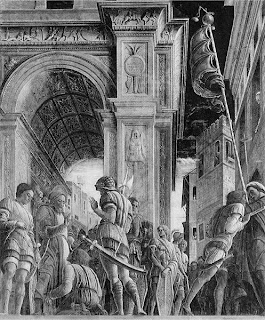Andrea
Mantegna was a prominent Italian Renaissance artist who lived from
1431-1506. His most famous work, Lamentation
over the Dead Christ, is distinguished by
its mastery of perspective and foreshortening. Mantegna’s skill with this quality of realism make his works
both intricately intruiging and difficult to recreate.
The
Italian city of Padova houses some f Mantegna’s early frescoes in the Ovetari
Chapel (dedicated to the lives of Saint James and Christopher), which lies
close to Giotto’s Scrovegni Chapel.
Regrettably, during the second World War the Allies destroyed many of
his frescoes here during an air strike; however, during the 1920s they had been
photographed in black and white, and are now in the process of restoration.
These
frescoes provide an excellent example of Mantegna’s early experimentaion with
foreshortening and complicated perspective. In one example, St. James Led to His Execution, Mantegna creates two point perspective – in the
foreground he creates a v-shaped line of people who recede into the background,
and in the upper portion he mimics this with the tops of the buildings and an
arches hallway. Mantegna’s precise
attention to this scientific pattern adds a dimension of reality receding into
space, as if there is no end to his image. The artist was a master of three dimensionality, even in his
early career. Mantegna’s
complicated frescoes create an illusion of reality. They are not as spacially balanced as some images from
contemporary artists, yet they harmoniously work together because of his
attention to perfecting linear perspective and foreshortening.


No comments:
Post a Comment